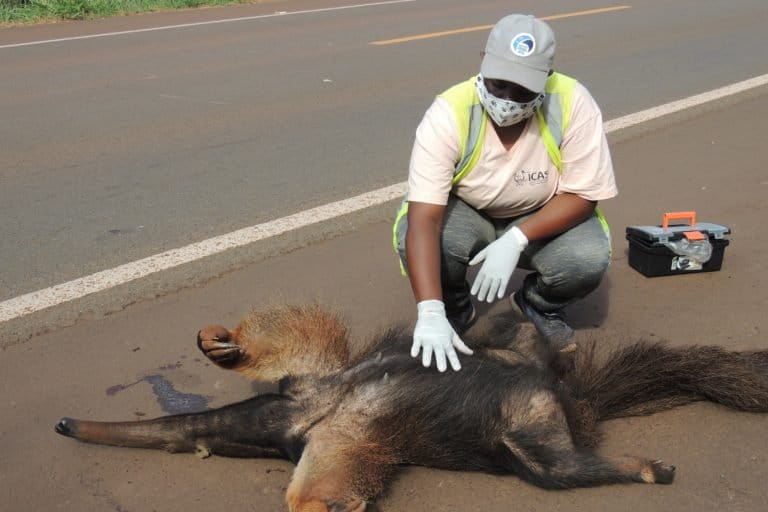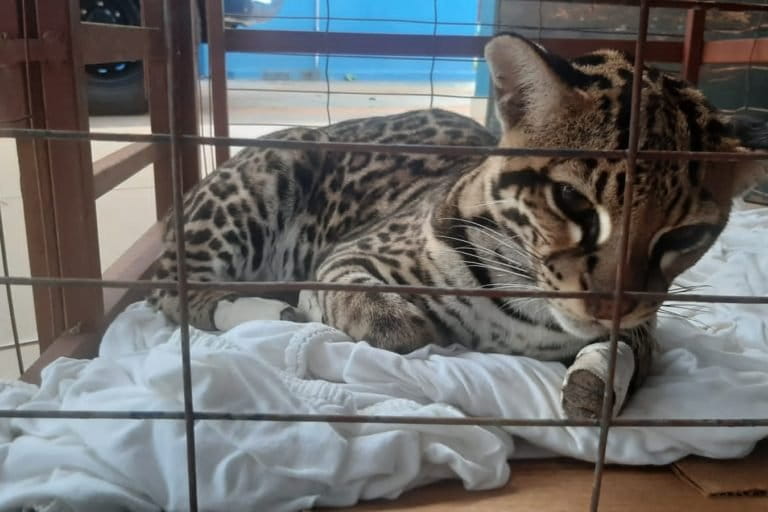- More than 12,000 wild animals were killed on the roads in Brazil’s Mato Grosso do Sul state between 2017 and 2020, including threatened species such as tapirs and giant anteaters.
- The real death toll is likely much higher, conservation groups say, as that number is based only on the carcasses found on the road; in many cases, the animals survive the initial collision but die elsewhere, or else the carcass is dragged away by scavengers.
- The deadliest stretches are on three roads: BR-262, BR-267 and MS-040, the main links between Mato Grosso do Sul’s capital, Campo Grande, and the state of São Paulo.
- In Bonito, a popular ecotourism destination in the state, NGOs are working with the government on measures such as speed bumps and suspended crossings that they hope can be replicated throughout Mato Grosso do Sul.
The figures vary and come from different sources, including the government, but they all point to the wildlife massacre taking place on the roads of Brazil’s Mato Grosso do Sul state. Each year, thousands of animals die after being run over on a road network of just over 3,000 kilometers (1,800 miles), with few structures in place to provide for safer crossings.
But nongovernmental organizations are taking action and managing to get public authorities to mobilize, even if opportunistically, in an attempt to change the situation.
The most detailed survey on wildlife killed on the state’s roads was conducted by the Wildlife Conservation Institute, known by its Portuguese acronym as ICAS. The survey monitored several stretches of roads and highways several times, covering a combined 85,000 km (53,000 mi) between 2017 and 2020 for the Bandeiras e Rodovias (“Anteaters and Highways”) project. It recorded 12,400 animals killed. Of these, 761 were giant anteaters (Myrmecophaga tridactyla), the project’s focal species.
“We used to cover 1,300 kilometers [8,000 miles] every 15 days. In total, we monitored around 15% of Mato Grosso do Sul’s paved roads,” says ICAS president and zoologist Arnaud Desbiez.
While the total number may seem high, the real death toll is even higher. That’s because most carcasses disappear from the roads without being accounted for by monitoring campaigns, Desbiez says. In the case of giant anteaters, for every carcass the surveyors found, three more had either been disposed of, dragged away by scavengers, or otherwise gone missing from the scene of the accident.
“And we also have to take into account the animals that are run over but manage to leave the road and end up dying in the bush. These individuals are not located by our teams,” Desbiez says.
Other studies by ICAS concluded that half of giant anteaters that are run over on paved roads die away from the road. The finding came from monitoring of more than 70 giant anteaters that had been fitted with tracking devices: eight of these individuals were hit by vehicles, six of them on paved roads, and three of the carcasses ended up far from the asphalt.

Seven tapirs killed a month
In addition to ICAS, the Lowland Tapir Conservation Initiative, known as INCAB in Portuguese, also studies the problem of wildlife being run over in Mato Grosso do Sul. Between 2013 and 2019, its researchers monitored almost 6,000 km (3,700 mi) of 28 state and federal roads, recording 501 dead Brazilian tapirs (Tapirus terrestris). INCAB is currently processing data from its latest survey, carried out in 2020-2021, but the preliminary conclusion is that, from March 2013 to March 2020, 613 tapir carcasses were found on 34 stretches of road in the state. That’s about seven tapirs a month.
In the first six years of monitoring, the study found that 10 key stretches of the BR-262, BR-267 and MS-040 highways — the main roads linking the Mato Grosso do Sul state capital, Campo Grande, to the state of São Paulo — accounted for around 80% of tapir roadkill.
In a statement to Mongabay, the National Department of Transportation Infrastructure (DNIT) said it had installed wildlife fences as well as two suspended crossings over the stretch of BR-262 being repaved between the municipalities of Anastácio and Corumbá, in keeping with environmental licensing requirements. The DNIT did not clarify whether there was similar infrastructure in place on the stretch of the BR-267 from the São Paulo state border to Porto Murtinho, which is also being repaved.

Potential solutions still not implemented
The situation on state highway MS-040 is even deadlier, with 135 tapirs killed there between 2013 and 2019. That’s made it a special focus for the team headed by INCAB coordinator Patrícia Medici.
Work on a 230-km (143-mile) stretch linking Campo Grande to Santa Rita do Pardo, and cutting through numerous fragments of Cerrado grassland, began in 1994, with the road fully paved by 2014. But due to the high incidence of roadkill and a failure to implement a plan to monitor the problem and reduce it — as required by environmental licensing regulations — the Public Prosecution Service launched a civil investigation in 2016.
As part of the investigation, INCAB in 2017 conducted a technical structural survey of the road to develop proposals for mitigating roadkill.
“The work identified more than 50 underpasses built for cattle or for draining the land, which could be adapted for wildlife,” says Medici, who submitted all the findings to the prosecutors and the state government. The main adaptation necessary, she says, is the installation of fences to direct the animals to these crossing points.
But the proposals have still not been implemented. The Mato Grosso do Sul State Agency for Enterprise Management (AGESUL), which operates under the Department of Infrastructure, reported that INCAB’s plan was incorporated into program Estrada Viva, a state government effort to reduce wildlife roadkill on several roads.
The Public Prosecution Service’s investigation resulted in a 2018 civil action against the government of Mato Grosso do Sul, the State Environmental Institute (IMASUL), AGESUL, and companies that provide services to the state. In a statement to Mongabay, State Prosecutor Luiz Antônio Freitas de Almeida said preliminary hearings in the lawsuit would begin soon, when witnesses would be heard.
“We are having good talks with the current head of the Department of Infrastructure, Eduardo Riedel, and we may reach an agreement on improvements for MS-040 before a court decision,” Almeida says.

Collaborating on solutions
The problem of roadkill in Mato Grosso do Sul isn’t new; conservation NGOs have been studying it and bringing it to public attention for years. State authorities have also outlined some initiatives to address the problem. But it was only in 2021 that separate actions converged to spark an organized mobilization that started in Bonito, one of Brazil’s main ecotourism destinations. NGOs under the banner of Bonito Não Atropela (“Bonito doesn’t run over”) are working with the authorities, and the results to date have been positive.
Bonito Não Atropela includes the Raquel Machado Institute, the National Network for Conservation Units, Ampara Silvestre, the Neotropic Foundation of Brazil, ICAS, and ViaFauna.
“The project emerged from the need to do something effective to save both animals’ and people’s lives,” says Ampara Silvestre research manager Maurício Forlani. “We can’t accept that dozens of wild animals die on roads around Brazil’s ecotourism capital. Our main goal is to turn the roads in the Bonito area into references of safety for local wildlife and its users.”
According to Forlani, the local road network, especially MS-178 and MS-382, had no infrastructure to reduce roadkill. Daily accidents involved six-banded armadillos (Euphractus sexcinctus), collared anteaters (Tamandua tetradactyla), crab-eating foxes (Cerdocyon thous) and black-striped capuchin monkeys (Sapajus libidinosus) were the most frequently killed animals. Giant anteaters, tapirs and ocelots (Leopardus pardalis) were also common victims.
Members of Bonito Não Atropela first got the support of the city government and later of the state secretary of infrastructure, Eduardo Riedel. This support, and efforts to raise funds and materials, enabled the construction of two wildlife crossings and two speed bumps near the town of Bonito. These structures are part of a set of three (on MS-382, Estrada do Turismo, and MS-345) to mitigate roadkill in the area. There’s also a connectivity plan for tree-dwelling animals, which consists of building 11 suspended crossings.

“The city government is a partner in the initiative by providing funds to build suspended wildlife crossings,” the Bonito government said in a statement to Mongabay. “And the municipal environmental department created an annual educational project to defend and protect wildlife, addressing the issue of roadkill.”
Forlani says Bonito Não Atropela’s next step is to expand its operations to the Serra da Bodoquena area, home to a national park.
The collaboration between Bonito Não Atropela and Riedel, who is running for governor in this year’s elections, resulted in the publication of the “Manual of Technical Guidelines for Mitigating Collisions of Vehicles with Wildlife on State Roads in Mato Grosso do Sul.” NGOs, businesses and authorities worked together to prepare the guide, which was published in December 2021 and “provides technical guidelines for new state road projects as well as the practical application in some works already in progress.”
The manual was included into the Estrada Viva (“Living Roads”) program, initiated by the state government in 2016 in partnership with Mato Grosso do Sul State University. It monitors six roads, identifying stretches where roadkill is most common and the species most affected.
INCAB’s Medici says this is yet another instance of the authorities acting only when there’s pressure from society for action.
“I’ve been working with this issue of roadkill in Mato Grosso do Sul long enough to have become somewhat skeptical regarding government agencies in the state,” she says.
She suggests the manual was only published because Riedel “took the lead” in that effort, adding that time will tell whether the state secretary of infrastructure is really interested in solving the problem or acting with an eye on the upcoming elections.
Banner image of a giant anteater that was run over on a Mato Grosso do Sul road. Image courtesy of ICAS.
This story was reported by Mongabay’s Brazil team and first published here on our Brazil site on March 31, 2022.
